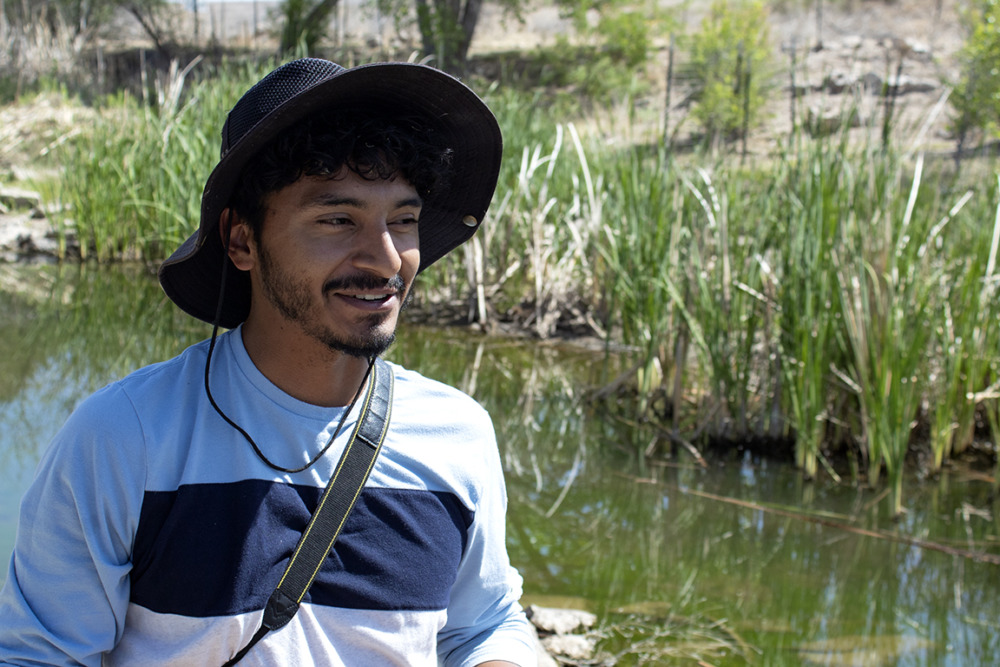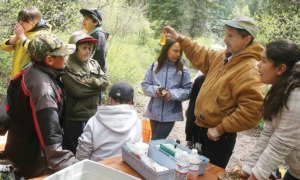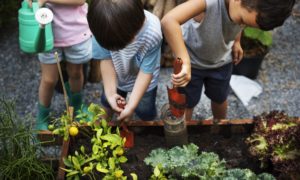LAS CRUCES, N.M. — La Mancha Wetland Park in Las Cruces, New Mexico, is a cool oasis in the spring heat of the surrounding desert for the beavers, turtles and birds that frolic in its waters and willow trees.
The park, which is connected to the Rio Grande, is also a refuge for the young people who have dedicated themselves to restoring and managing an ecosystem under threat from climate change.
“I grew up in a community that was kind of detached from places like this, so we didn’t really have exposure to nature,” said Sergio Delgado, 29, a native of El Paso, Texas, another city along the Rio Grande, who volunteers every weekend at La Mancha.
He looks after native plants, removes non-native species and clears the pond of dead leaves and branches.
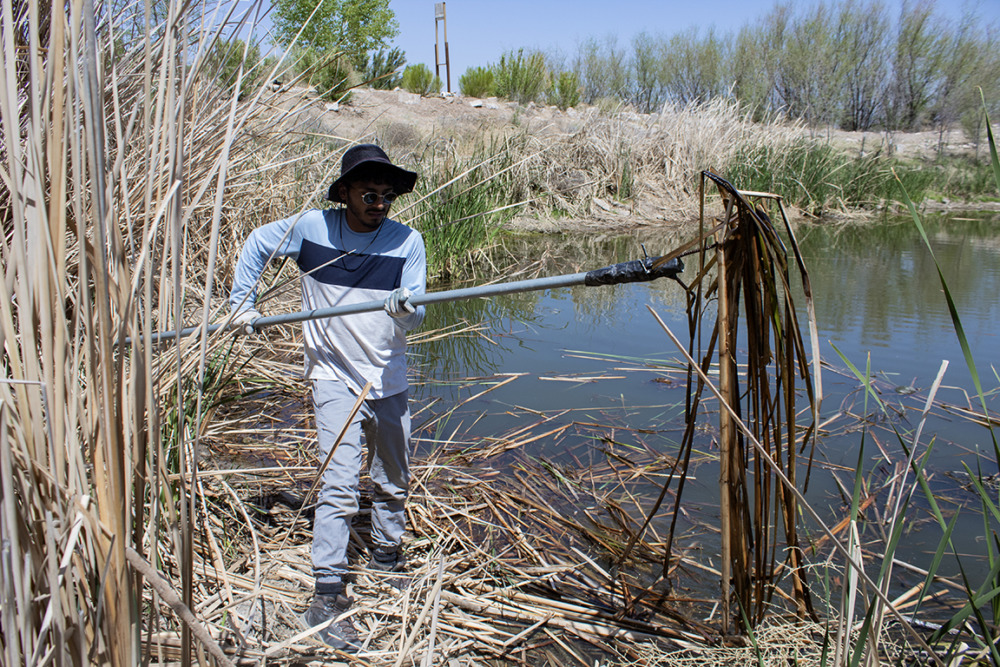
Javier Gallegos
Sergio Delgado clears a pond at La Mancha Wetland Park in Las Cruces, New Mexico, on April 30, 2022.
“I feel places like this help expand your mind to see what else is out there and spark a new passion,” said Delgado.
He is quick to point out that small projects like La Mancha can mitigate some of the damage to the river’s ecology, but they can’t solve the larger issues facing it.
“It’s a tiny Band-Aid on the giant wound that humans and the people in the past opened up,” Delgado said.
La Mancha is one of the many wetland restoration projects along the Rio Grande. Over the past century, with the introduction of different dams and the canalization of many stretches of the river, naturally occurring floodplains and riparian areas along the river have disappeared. At the same time, water flow has been declining decade after decade. The American West is experiencing its worst megadrought in over 1,000 years.
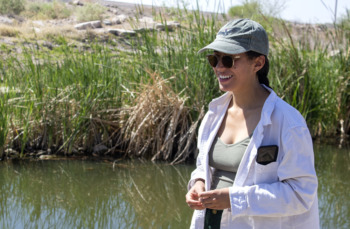
Javier Gallegos
Esperanza Chairez Uriarte, 24, of Nuestra Tierra Conservation Project, a nonprofit organization that seeks to provide communities of color with sustainable access to public lands.
“I think it’s important for youth in Las Cruces to understand what the river used to look like and understand that what they see the majority of the year – just this dry, empty river – isn’t the reality of what this landscape used to look like,” said Esperanza Chairez Uriarte, 24, of Nuestra Tierra Conservation Project, a nonprofit organization that seeks to provide communities of color with sustainable access to public lands.
“They have a role in shaping that future,” she added.
Nuestra Tierra owns and manages La Mancha. They encourage the community to spend time in the park and frequently have events there that promote restoration of the environment.
Uriarte said she believes it can inspire hope in people, especially younger generations, by showing how the environment along the Rio Grande can thrive if maintained.
The park is approximately four acres with a pond at its center. The pond was artificially created by digging deep enough to fill the hole with natural ground water, though it can receive water from the Rio Grande during the wet season. Construction was completed in 2016 with the intention of helping preserve the freshwater fish population that had been dying steadily as the Rio Grande dries up.
Related Stories
• After a win for U.S. climate change education, classroom implementation is off to a slow start
• What are green jobs and how can I get one? 5 questions answered about clean energy careers
• Latino activism leads in grassroot efforts on climate change
• Youth and climate change: How a generation is adapting while fighting for their future
Alex Mayer, director of the Center of Environmental Resource Management at the University of Texas in El Paso, said there are multiple reasons the Rio Grande is drying up. He has spent his career researching water management and has worked on many projects dealing with water scarcity, human infrastructure, and climate change.
“There has been a cycle, more than 20 years by now, of low snowpack,” Mayer said. “The water that we see in Las Cruces and El Paso is really snowmelt. There has been less snowpack, the snowpack [is] melting earlier and more quickly, which has these feedback effects.”
He explained snowpack melting fast means reservoirs may not be able to capture all the water that is released in a short amount of time. In the past, the snow melted more slowly, creating a slower, steadier stream.
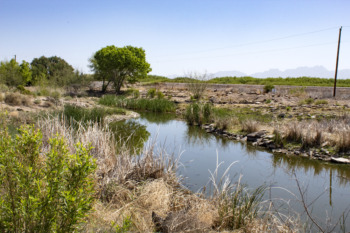
Javier Gallegos
La Mancha Wetland Park is approximately four acres with a pond at its center. The pond was artificially created by digging deep enough to fill the hole with natural ground water, though it can receive water from the Rio Grande during the wet season.
Mayer also said as global temperatures rise, evaporation increases, which depletes the water that is stored in reservoirs along the river.
It is because of this uncertain water availability that the Rio Bosque Wetland Park in El Paso, Texas, is so reliant on artificially supplied water.
Rio Bosque is a 372-acre park located in east El Paso along a part of the Rio Grande that is heavily canalized due to the border between the United States and Mexico.
The wetland is supplied by multiple large pumps around the park that create a series of ponds. The source of the park’s water is mostly treated wastewater, but also groundwater and irrigation from the river at certain times of year.
Like La Mancha in Las Cruces, the Rio Bosque is heavily reliant on volunteer work. The large park has only two full-time staff members for daily maintenance, so community workdays are held every month to provide additional assistance necessary for the park to thrive.
Gloria Hernandez, 18, a local high school senior, said she started volunteering at the park to learn more about the environment and the local impacts of global warming.
One senior contacted Klock after the end of the semester to say that he had always heard that climate change was important, but now he finally got it.
“I started hearing about climate change and I was like, ‘What is that?’” she said. “I wanted to see how it was affecting my region here in El Paso.”
Hernandez has become active in her school’s environmental club.
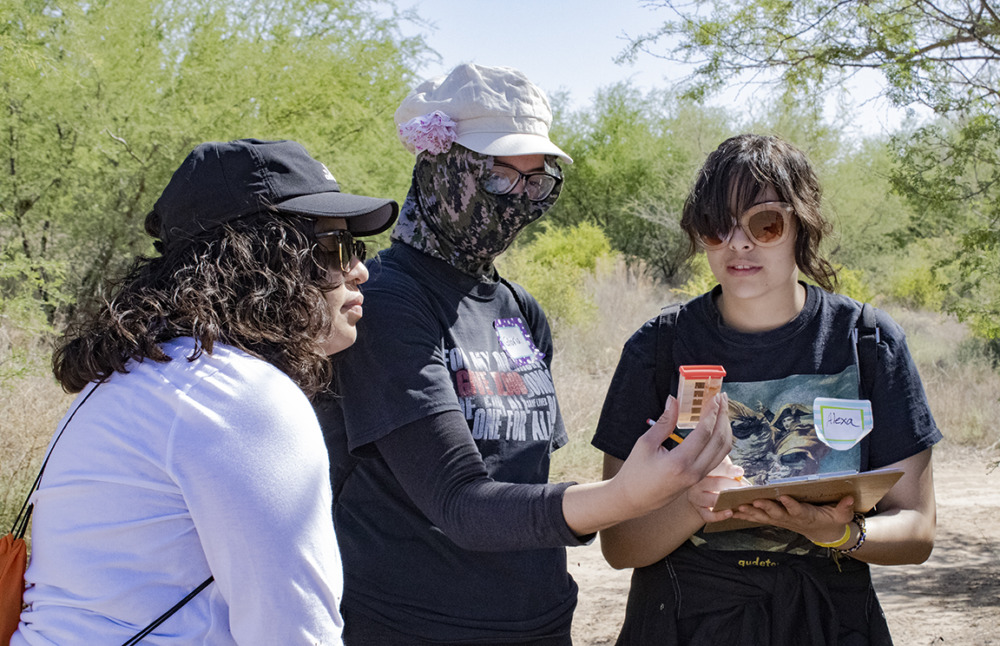
Javier Gallegos
High school students test water samples at Rio Bosque Wetland Park in El Paso, Texas on May 21, 2022. From left: Emily Torres, Gloria Hernandez, and Alexa Farpon. Hernandez said restoring wetlands in her community gives her hope for the future.
She and the rest of the club members have been in the process of restoring one acre of land by removing invasive species and maintaining native ones. They also do additional field work, like testing water samples and measuring the biodiversity of plants.
The student volunteer work is supported by Insights El Paso Science Center, a local nonprofit that covers the cost of transportation, substitute teacher pay, materials and supplies.
“This work couldn’t be possible without community contribution and help from the students,” said Jennifer Ramos-Chaves, the environmental education manager at Insights.
As the waters of the Rio Grande dwindle year by year, these parks offer glimpses into a natural world that is disappearing throughout the watershed. Organizers say that volunteers, including many youth, help preserve pockets of this ecosystem in the hopes that one day it can be restored at a larger scale.
“It makes me feel very hopeful,” said Hernandez, the high school student. “I can’t wait to see what it looks like in a decade. I hope to bring my children here someday.”
***
Javier Gallegos is a photographer and journalist who recently graduated from New Mexico State University with a degree in journalism. He is from El Paso, Texas, and spent his time at college in Las Cruces, New Mexico. He is interested in American history and spends much of his free time writing and playing video games.


